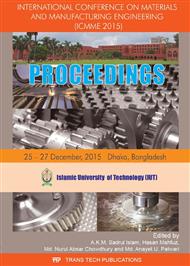p.129
p.134
p.140
p.146
p.152
p.158
p.165
p.173
p.179
Effect of Chromium and Nickel Additions on the Transformation Characteristic and Ferrite Grain Size Refinement of Low Carbon Structural Steels Containing 0.13% C
Abstract:
The effect of small addition of chromium and nickel alone or in combination on the transformation characteristic and ferrite grain size of low carbon (0.13%C) structural steels have been studied by cooling suitable steels at four different cooling rates ranging from 120°C/min to 3.6° C/min from temperatures giving a constant austenite grain size of 37 μm. Radio Frequency generator with control system was used for the heat treatment of the steel samples. Optical microscopy of the heat treated samples was carried out. Ferrite grain size was determined from the fictitious ferrite grain size measured by mean linear intercept method and the volume fraction of pearlite obtained by optical microscopy and point counting. It was found that although the heat treatment of the steels was started from a common austenite grain size, their subsequent ferrite grain size after cooling at the same cooling rate were not the same. Both chromium and nickel enhance the formation of Widmanstatten structure. But chromium is more effective than nickel in the formation of Widmanstatten structure. It was also found that the undissolved particles of chromium carbide (Cr2C) present during austenitizing have no role in determining the ferrite grain size. The precipitating particles of chromium carbide (Cr2C) are excellent ferrite grain size refiners. Nickel refines the ferrite grain size. In presence of nickel, Cr2C precipitates are less effective than Cr2C precipitates in absence of nickel in the refinement of ferrite grain size.
Info:
Periodical:
Pages:
158-164
Citation:
Online since:
December 2016
Authors:
Price:
Сopyright:
© 2017 Trans Tech Publications Ltd. All Rights Reserved
Share:
Citation:


